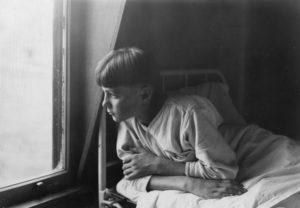The State Reform School for Boys was displaced from its original location by the Westborough Insane Hospital (later known as the Westborough State Hospital) in 1884. As part of the change, the school was renamed the Lyman School for Boys and was moved to Powder Hill off of Route 9 and along Oak Street.
The photographs in this exhibit were all taken between the years 1905 and 1912, roughly one hundred years after the indentured servant contracts were issued in Westborough.
Changing Notions of Childhood in the Nineteenth Century
The onset of the Industrial Revolution had profound effects on work, the family unit, and conceptions of childhood. In the early 1800s, labor began to shift away from household farms and into textile mills and other factories. Along with this shift, husbands who left the home to work in these new settings were increasingly expected to provide for their families as the single breadwinner. Wives were now tasked with not only keeping the household but raising the children. And apprentices and hired laborers who used to work on the farm now moved out the individual houses and into boarding houses and working-class neighborhoods.
Public schools also began to proliferate in New England communities during this time, so children spent less time at home and less time working for the family. Children were ceasing to be economic assets for the individual family and becoming economic liabilities who required investment and education. Rather than functioning as “little adults,” children now demanded special care and institutions. They were increasingly seen as innocent, impressionable creatures who needed protection from the harsh realities of adult life during the early period of their lives.
By the mid-nineteenth century, a new attitude towards children had developed. Rather than see childhood as a time to teach children discipline and deference to authority—and with it education in how to serve as a functional role in the economic family unit—it was now seen as a period of growth, development, and preparation for adulthood. All of these changes resulted in new definitions of childhood, which itself was eventually divided up into even smaller developmental periods with the invention of “adolescence” around the turn of the century.
With changes brought about by the Industrial Revolution, rapidly expanding urban centers, increasing population and immigration, and new ways of thinking about childhood, children beset by poverty, abandonment, and abuse became a major focus of public attention in the second half of the nineteenth century. New methods for tackling such problems in this new social environment needed to be created: child welfare now became institutionalized to handle the demand.
Go to the next page in the exhibit: Work.
* * *
Exhibit Navigation for “Changing Pictures of Childhood: A Comparative History of Child Welfare in Westborough”:
-
- Introduction
- Pauper Apprenticeship – Childhood in Early America
- Lyman School for Boys – Childhood in the Nineteenth Century
